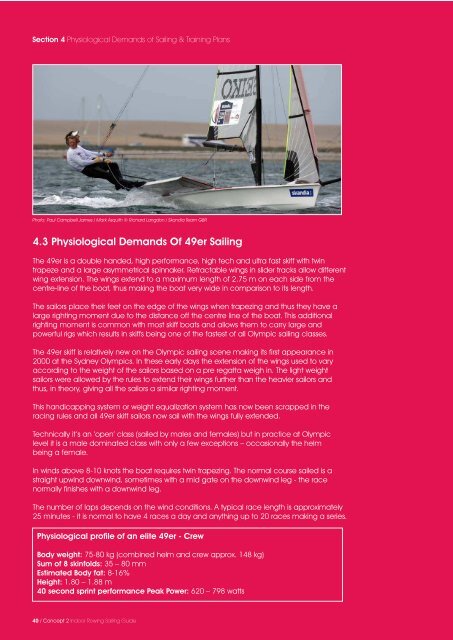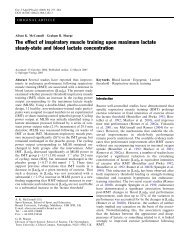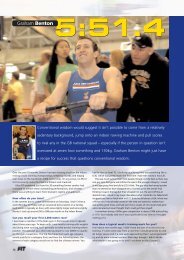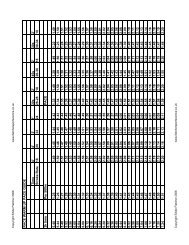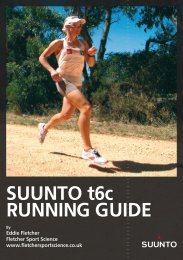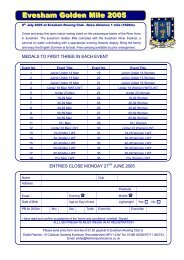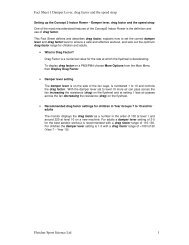Concept2-Sailing Rowing Guide.indd - Fletcher Sport Science
Concept2-Sailing Rowing Guide.indd - Fletcher Sport Science
Concept2-Sailing Rowing Guide.indd - Fletcher Sport Science
You also want an ePaper? Increase the reach of your titles
YUMPU automatically turns print PDFs into web optimized ePapers that Google loves.
Section 4 Physiological Demands of <strong>Sailing</strong> & Training Plans<br />
Photo: Paul Campbell James / Mark Asquith © Richard Langdon / Skandia Team GBR<br />
4.3 Physiological Demands Of 49er <strong>Sailing</strong><br />
The 49er is a double handed, high performance, high tech and ultra fast skiff with twin<br />
trapeze and a large asymmetrical spinnaker. Retractable wings in slider tracks allow different<br />
wing extension. The wings extend to a maximum length of 2.75 m on each side from the<br />
centre-line of the boat, thus making the boat very wide in comparison to its length.<br />
The sailors place their feet on the edge of the wings when trapezing and thus they have a<br />
large righting moment due to the distance off the centre line of the boat. This additional<br />
righting moment is common with most skiff boats and allows them to carry large and<br />
powerful rigs which results in skiffs being one of the fastest of all Olympic sailing classes.<br />
The 49er skiff is relatively new on the Olympic sailing scene making its first appearance in<br />
2000 at the Sydney Olympics. In these early days the extension of the wings used to vary<br />
according to the weight of the sailors based on a pre regatta weigh in. The light weight<br />
sailors were allowed by the rules to extend their wings further than the heavier sailors and<br />
thus, in theory, giving all the sailors a similar righting moment.<br />
This handicapping system or weight equalization system has now been scrapped in the<br />
racing rules and all 49er skiff sailors now sail with the wings fully extended.<br />
Technically it’s an ‘open’ class (sailed by males and females) but in practice at Olympic<br />
level it is a male dominated class with only a few exceptions – occasionally the helm<br />
being a female.<br />
In winds above 8-10 knots the boat requires twin trapezing. The normal course sailed is a<br />
straight upwind downwind, sometimes with a mid gate on the downwind leg - the race<br />
normally finishes with a downwind leg.<br />
The number of laps depends on the wind conditions. A typical race length is approximately<br />
25 minutes - it is normal to have 4 races a day and anything up to 20 races making a series.<br />
Physiological profile of an elite 49er - Crew<br />
Body weight: 75-80 kg (combined helm and crew approx. 148 kg)<br />
Sum of 8 skinfolds: 35 – 80 mm<br />
Estimated Body fat: 8-16%<br />
Height: 1.80 – 1.88 m<br />
40 second sprint performance Peak Power: 620 – 798 watts<br />
40 / Concept 2 Indoor <strong>Rowing</strong> <strong>Sailing</strong> <strong>Guide</strong><br />
Section 4 Physiological Demands of <strong>Sailing</strong> & Training Plans<br />
Physiological profile of an elite 49er - Helm<br />
Body weight: 68-73 kg<br />
Sum of 8 skinfolds: 65 – 90 mm<br />
Body fat: 12-16%<br />
Height: 1.74 – 1.80 m<br />
40 second sprint performance Peak Power: 420 – 706 watts<br />
Requirements – 49er<br />
Power and strength – hoisting the kite requires power (speed and strength)<br />
Aerobic fitness – the amount of recovery upwind will depend on the ability<br />
to consume oxygen<br />
Weight control – body weight varies from crew to crew. Most crew’s take<br />
some effort to lose weight to avoid their combined weight going over 148kg<br />
Agility – an important aspect of fitness, in this boat there is a need to be<br />
nimble and fast this is particularly the case due to the additional width of a<br />
skiff due to the extended wings from which the sailors trapeze<br />
Core strength – a must for sailing - rowing should be an integral part of any<br />
good all round training plan<br />
Specific rowing sessions can be targeted at improving power and<br />
strength, aerobic conditioning and weight control<br />
Heart Rate Requirement 49er crew and helm<br />
It is clear from looking at any physiological data from skiff sailing that the<br />
crew of a skiff boat works a lot harder than the helm and subsequently the<br />
physiological requirements and training regimen of the two will vary. The skiff<br />
crew tends to be the ‘power-house’ of the boat controlling the powerful sails<br />
whereas the helm requires fine skill in steering the boat at high speeds but<br />
does not require super-fitness.<br />
49er skiff Crew: In winds above 8-10 knots the physical demands placed<br />
on the crew are ‘high’. Downwind legs are more demanding than upwind<br />
legs and heart rate may be between 85%-90% of maximum heart rate<br />
- this is due to the large asymmetrical spinnaker and the relative large loads<br />
associated with it.<br />
It is normal for a skiff crew to take the mainsheet controlling the main sail<br />
when sailing upwind and thus allow the helm to concentrate on accurate<br />
steering. In increasing wind strength or in conditions with sudden gusts of wind<br />
the controlling of the mainsail is a demanding job for the crew. However,<br />
upwind heart rate is approximately 75% of maximum heart rate – and does<br />
offer a brief recovery period for the crew in comparison to sailing downwind<br />
in similar conditions.<br />
In lighter conditions of 4 to 8 knots the physical demands are ‘low’ with more<br />
focus on agility and flexibility and the art of moving around the boat without<br />
upsetting its momentum is a crucial skill.<br />
Hoisting the spinnaker is an important part of a crew’s role and takes<br />
approximately 5-7 seconds of flat out effort – a wet spinnaker or a mast with<br />
twisted halyards is much harder to hoist. Peak HR coincides with the kite hoist.<br />
Concept 2 Indoor <strong>Rowing</strong> <strong>Sailing</strong> <strong>Guide</strong> / 41


